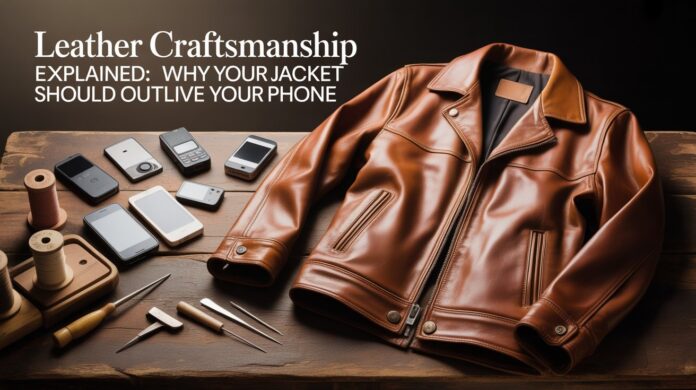Let’s be honest: most “leather” jackets sold online are glorified costumes. They look the part in a thumbnail—but wear them twice, get caught in a drizzle, or try zipping them past winter, and poof. Cracks. Stiffness. That weird plasticky smell.
A high-quality leather jacket? That’s different. That’s the one you buy in your twenties and still reach for at forty. The one that gets better with age—softer, richer, more yours. It doesn’t just keep you warm; it holds memories. Like that time you wore it to your first con as Daryl Dixon… or the road trip where it doubled as a pillow, a rain shield, and your confidence cloak.
So what’s the secret behind The Falcon Jacket? Not magic—just real craftsmanship. And it begins way before it reaches your door.
Real Leather Isn’t a Label—It’s a Story
Ever notice how some jackets feel alive? Like they breathe with you? That’s not marketing fluff. That’s full-grain leather—the top layer of the hide, untouched by sanding or heavy coatings. It’s got scars, pores, texture. Imperfections that prove it’s real.
Then there’s “genuine leather”—a term that sounds legit but is actually the lowest grade. It’s made from shredded scraps glued together and painted over. It peels. It cracks. It dies young.
And don’t get me started on bonded leather. That’s basically leather-flavoured cardboard.
If you’re investing in a high-quality leather jacket, you want either full-grain (the gold standard) or top-grain (sanded slightly for a smoother look, but still durable). Anything else? Save it for Halloween.
Fun fact: Our best-selling Women’s Leather Jackets—like the sleek Ava Moto or the vintage-inspired Lana Trench—use top-grain sheepskin. Why? Because it’s tough and buttery soft. Perfect for daily wear that still turns heads.
Not All Leather Is Created Equal (And Neither Are the Animals)
Cowhide? Tough as nails. Great for biker jackets or anything you’ll throw on a motorcycle or wear to a muddy festival. Heavy, structured, built to last.
But if you want something that drapes like a second skin—lightweight, supple, quiet—go for sheepskin or lambskin. That’s the stuff luxury brands use for women’s styles. It moves with you, not against you. And yeah, it’s pricier—but try wearing stiff cowhide under a blazer. It’s not happening.
Suede and nubuck? Gorgeous, but high-maintenance. Save those for dry-season statement pieces.
The Devil’s in the Details (And So Is the Quality)
You can spot a cheap jacket in three seconds if you know where to look:
Zippers: If it’s not YKK (or RiRi, or Talon), it’s not serious. Plastic zippers jam, warp, and snap. Metal ones? They’ll outlive your grandkids.
Stitching: Run your fingers along the seams. Are they tight, even, double-stitched at stress points? Or loose, wobbly, single-threaded? Hand-stitched jackets often use waxed thread—it’s stronger, water-resistant, and ages beautifully.
Lining: Polyester feels cheap and traps sweat. Satin, cotton, or Bemberg? That’s the good stuff. Breathable, smooth, and kind to your clothes underneath.
Edges: No glue globs. No fraying. Just clean, sealed edges that say, “Someone cared.”
I’ve seen jackets that survived three back-to-back cons, daily commutes, and one very dramatic breakup—all because the hardware didn’t quit and the seams held strong.
“But It’s So Expensive!” — Let’s Talk Value
Yeah, a proper handcrafted leather jacket costs more upfront. But think long-term:
A £120 “genuine leather” jacket? Gone in 18 months.
A £380 full-grain piece? Still going strong at 15 years.
That’s £25 a year. Less than your monthly Netflix bill.
And unlike fast fashion, it improves. The collar darkens from your hair oil. The elbows soften from leaning on desks. The colour deepens into a patina—a one-of-a-kind finish no factory can fake. That’s not wear and tear. That’s earned.
What About Ethics? Can Leather Be Responsible?
Good question—and yes, it can.
The best leather comes from by-products of the food industry (no animals harmed just for fashion). And the tanning method matters:
Vegetable tanning uses tree bark and natural tannins. It’s slower, but cleaner and kinder to the planet.
Chrome tanning is faster but toxic—avoid brands that don’t disclose their process.
We work with small tanneries that recycle water, use plant-based dyes, and waste as little hide as possible. Because looking cool shouldn’t cost the earth.
How to Keep Your Jacket Alive for Decades
Leather’s tough—but it’s not indestructible. Treat it right, and it’ll thank you:
- Clean gently: Damp cloth only. No soap. Ever.
- Condition every few months: Use a proper leather conditioner (we swear by beeswax-based ones). Dry leather cracks.
- Hang it right: Use a wide, padded hanger. Folding = permanent creases.
- Keep it dry: If it gets wet, air-dry away from heat. And always use a water-repellent spray before rainy season.
- Wear it: Seriously. Leather loves body heat and movement. Storing it untouched for years? That’s how it gets stiff.
Pro tip: We’ve got a full care guide for our Women’s Leather Jackets—because we want yours to look killer in 2040, not just 2025.
Final Thought: Your Jacket Should Be a Heirloom, Not a Trend
A high-quality leather jacket isn’t just clothing. It’s a companion. It’s the piece you throw on when you need to feel unstoppable—whether you’re cosplaying as Eleven, heading to a job interview, or just walking the dog on a foggy morning.
And when it’s made right—with real hides, honest stitching, and hardware that means business—it won’t just last. It’ll live.
So skip the imitations. Go for the real thing.
Ready to find your forever jacket?Explore our Women’s Leather Jackets Collection —crafted for fans, built to last, and designed to tell your story.

